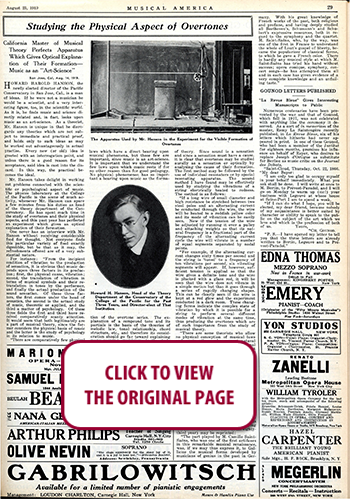 100 YEARS AGO IN MUSICAL AMERICA (302)
100 YEARS AGO IN MUSICAL AMERICA (302)
August 23, 1919
Page 29
Studying the Physical Aspect of Overtones
California Master of Musical Theory Perfects Apparatus Which Gives Optical Explanation of Their Formation—Music as an “Art-Science”
San Jose, Cal, Aug. 14, 1919.
HOWARD HAROLD HANSON, the newly elected director of the Pacific Conservatory in San Jose, Cal., is a man of ideas. If he were not a musician he would be a scientist, and a very interesting figure, too, in the scientific world. As it is, he finds music and science directly related and, in fact, looks upon music as an art-science. As a theorist, Mr. Hanson is unique in that he disregards any theories which are not subject to immediate and practical proof, and holds only to such ideas as may be worked out advantageously in actual practice. Every new (or old) idea is greeted with an interrogation point, and unless there is a good reason for its acceptance, said idea is cast into the discard. In this way, the practical becomes the ideal.
Mr. Hanson takes delight in working out problems connected with the scientific or psychological aspect of music. The physics laboratory at the College of the Pacific is the scene of much activity, whenever Mr. Hanson can spare a few minutes from his duties as head of the theory department of the Conservatory. He has spent much time in the study of overtones and their physical aspects, and this past year has perfected an experiment which gives an optical explanation of their formation. One never has an interview with Mr. Hanson without receiving considerable food for thought. Not everyone finds this particular variety of food exactly digestible, but be that as it may, the refreshments offered are of a very substantial nature.
For instance: “From the incipient condition of vibration to the production of sensation, it is obvious that music depends upon three factors in its production; first, the physical cause, vibration; second, the translation of vibration in terms of musical symbols and their retranslation in tones by the performer, and finally the actual production of the sound sensation. Of these three factors, the first comes under the head of acoustics, the second is the actual study of music, theoretic or applied, and the third a matter of psychology. Of these three fields the first and third have received comparatively scanty attention. It would seem that both legitimately are a part of musical theory, since the former considers the physical basis of music and the latter is the study of psychology in its relation to music.
“There are comparatively few physical laws which have a direct bearing upon musical phenomena, but those few are important, since music is an art-science. It is important that we understand the few laws upon which music rests if for no other reason than for good pedagogy. No physical phenomenon has so important a bearing upon music as the formation of the overtone series. The explanation of a compound tone and its partials is the basis of the theories of melodic law, tonal relationship, chord structure, etc., and therefore its consideration should go far toward explaining many seeming empiricisms in the study of theory. Since sound is a sensation and since a sensation must have a cause, it is clear that overtones may be studied aurally as a sensation or optically by analyzing the cause of their formation. The first method may be followed by the use of individual resonators or by special resonating apparatus. The second method I have found may be effectively used by studying the vibrations of a string electrically heated to redness. The method is as follows:
“If a long wire of small diameter and high resistance be stretched between two steel poles and an alternating current be conducted through the wire, the wire will be heated to a reddish yellow color and its mode of vibration can be easily seen. Now if the tension of the wire be adjusted by running it over a pulley and attaching weights so that its natural frequency is a fractional part of the frequency of the alternating current cycle the wire will vibrate in a number of equal segments separated by nodal points.
“For example, if the alternating current changes sixty times per second and the string is ‘tuned’ to a frequency of ten vibrations per second, six vibrating segments will appear. If, however, sufficient tension is applied so that the wire gives a definite tone and the wire is plucked with a glass rod, it will be seen that the wire does not vibrate in a simple motion but that it goes through a series of rapidly changing shapes. This can be clearly seen if the wire is kept at a red glow and the experiment conducted in a dark room. These changing forms indicate the complex state of vibration by which it is possible for a string to perform several different modes of vibration at the same time, thus producing the overtones which are of such importance from the study of musical theory.
“There are some theorists who allow no physical conception of musical laws and again others who pervert natural laws in the effort to prove some personal theory which, though ingenious, is not necessarily true. It would seem that the happy medium between the two would be a consideration of only the few actual laws which have to do with music and the exclusion of empirical theories which have little foundation in either art or science.” —MARJORY M. FISHER.




 RENT A PHOTO
RENT A PHOTO





